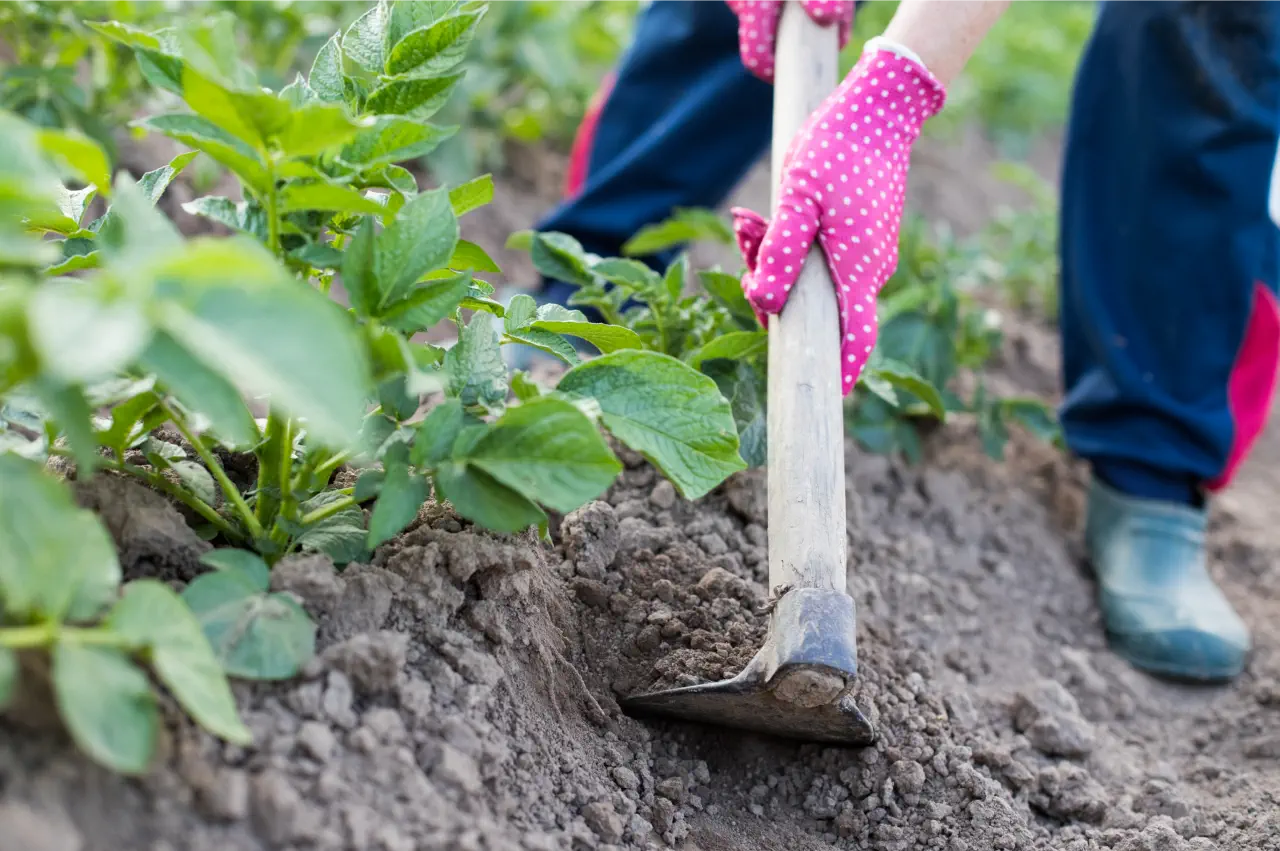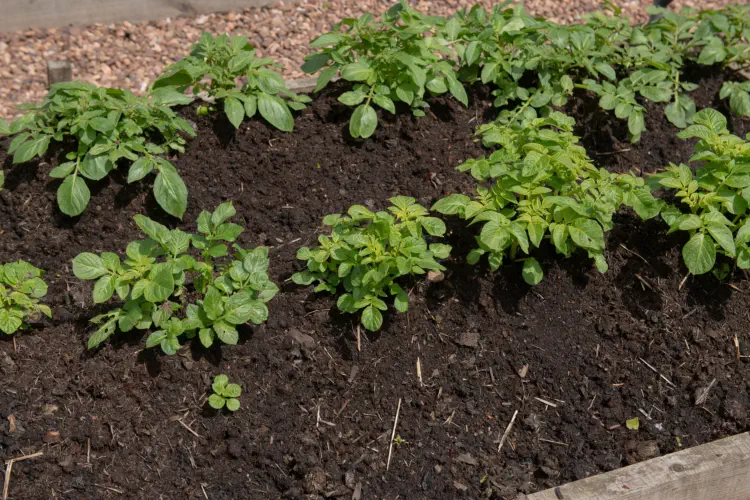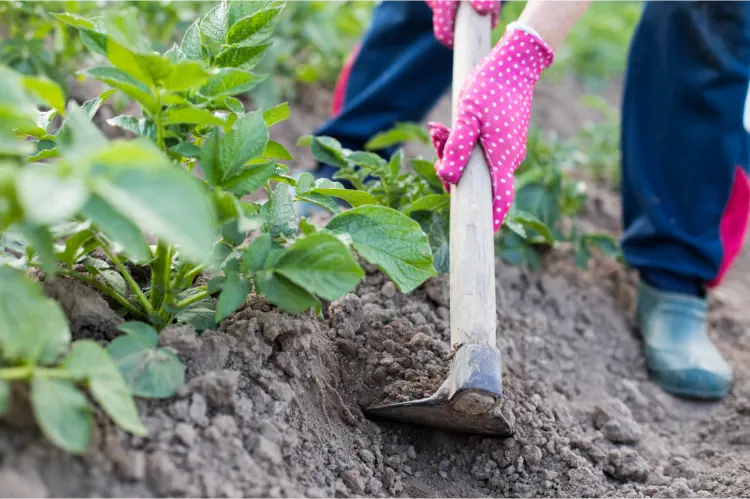Blight can wipe out your crop. Choosing the right blight resistant seed potatoes is crucial for a healthy harvest.
Read on to find out the top varieties of blight resistant seed potatoes that will save your yield....

When should you earth up potatoes, and how can you do it to secure the best yield? This guide cuts straight to the chase: practical, easy-to-follow steps for earthing up potatoes. Protect your potatoes from frost, keep them free from greening, and maximize your harvest with our expert tips.
Earthing up is essential in potato farming for protecting young plants from frost, preventing tubers from turning green due to light exposure, and maximising the crop yield by promoting growth along the stem.
The earthing up process should start when potato shoots are around 20cm tall and continue every few weeks until the ridge height reaches 20-30 cm, with soil being mounded around the growing stems while keeping some leaves exposed for photosynthesis.
Choosing well-draining, nutrient-rich and loose soil is critical for successful earthing up, and additional measures like adding compost, consistent watering, and effective weeding post-earthing up are vital for ensuring a healthy and productive potato crop.
In potato growing, earthing up is akin to laying the foundation of a house. It sets the stage for the growth of the plants and ultimately the yield of the crop. Creating a supportive and protective environment for the sprouting potato tubers involves mounding soil around the stems as the plants grow. This process is not only protective but also productive, contributing significantly to a healthy plant and a bountiful harvest.
The benefits of earthing up are three-fold:
It protects the shoots from late spring frost damage, acting as an insulating blanket against the harsh cold.
It ensures that the developing tubers are not exposed to light, which can turn them green and inedible.
By promoting the growth of potatoes along the stem, earthing up works to maximize your crop yield.

A young potato plant is, vulnerable and susceptible to environmental stressors. Earthing up acts as a significant protective measure, shielding the shoots from potential frost damage, which could otherwise stunt their growth and harm the plant. Imagine wrapping a baby in a warm blanket to protect it from the cold; that’s what earthing up does for your potato plants.
Not only does this process protect from the cold, but it also shields the tubers from sunlight. Exposure to light triggers a process that turns the tubers green and produces solanine, a toxic compound that renders the potatoes inedible. Mounding soil around the plant’s stems as they grow protects them from the harmful effects of sunlight exposure while enhancing their natural defenses against other environmental stress factors.
Similar to the optimal time for planting potatoes, there’s an ideal time to initiate the earthing up process. It’s not a one-time task, but rather a continuous process that starts when the potato shoots reach a certain height above the soil. So, when is the right time to start?
The process of growing potatoes typically involves several rounds of earthing up, which is essential as potatoes grow. Here’s how it works:
Once the shoots are about 23cm (9in) tall, it’s time for the first round of earthing up.
Subsequent intervals of earthing up are determined by the plant foliage reaching a height of about 20 to 30 cm.
When piling more soil onto the growing plant, ensure that the height is just under 12 inches tall so that some leaves remain exposed for photosynthesis.
With the basics now clear, let’s get our hands dirty! Earthing up is a practical task that requires a little bit of technique and a lot of patience. The procedure entails mounding soil around the potato plant’s leafy shoots, fostering the growth of underground stems that yield potatoes.
The initial earthing up should occur when the potato shoots reach about 23 cm in height. At this point, soil is drawn up around them to form a ridge, leaving the top 10 cm of the plants exposed. But the job doesn’t end there. The process of earthing up is repeated multiple times, with a few weeks between each round, until the final ridge height is between 20-30 cm, as the potato stems grow taller.
How does this process manifest in practice?

Consider initial earthing up as setting the stage for a grand performance. It’s the first step in a process that will eventually lead to a bountiful harvest of potatoes. The process starts with your potato plants in a trench approximately 15cm (6 inches) deep. Once the potato shoots have grown to about 9 inches tall, it’s time to begin earthing up.
To begin, draw up a ridge of soil around the potato shoots, leaving the top 4 inches of the plant exposed. This might seem like a straightforward task, but it requires a gentle touch and a keen eye. Carefully mound the soil around the base of the plants, taking care not to damage the shoots or roots in the process.
After the initial earthing up, the potato plants continue to grow, and so should the mound of soil around them. As the plants grow, you perform subsequent rounds of earthing up, adding more soil to form and sustain a ridge. This is a crucial step in protecting the developing tubers from sunlight and promoting better growth.
Earthing up is performed several times, a few weeks apart, each time mounding soil around the potato plant’s growing stems. In warm and moist conditions, where the potato plants grow rapidly, frequent earthing up may be necessary. The continued build-up of soil prevents sunlight from reaching new tubers, safeguarding them from greening and promoting better growth.
Selecting the ideal soil for earthing up parallels choosing the perfect ingredients for a recipe. Just as the quality of ingredients can make or break a dish, the type of soil used can significantly impact the success of your potato crop. The ideal soil for earthing up potatoes should be well-draining, nutrient-rich, and loose. This perfect combination plays a crucial role in promoting healthy tuber development.
Loose soil is preferred for mounding around potato plants as it aids in the expansion of underground stems, and facilitates easy covering and protection of the developing tubers. In addition, using loose, fertile soil or compost for earthing up is crucial for the health of the underground stems and to achieve an appropriate final height for the ridges. But how can you further enrich the soil to boost the growth of your potatoes?
Enriching your soil with compost equates to giving your potato plants a vitamin boost. It enhances soil structure, provides essential nutrients for potato growth, and helps conserve moisture. So, how do you go about it?
Incorporate well-rotted garden or commercial compost into the soil during the earthing up process. This not only enhances the nutrient content of the soil but also helps conserve moisture, promoting tuber swelling. If you’re growing potatoes in containers, adding layers of compost as the shoots grow helps with nutrient supply and moisture conservation, ensuring healthy and robust potato plants. To further improve the soil quality, consider adding more compost.

The work doesn’t conclude with earthing up your potatoes. Maintaining consistent soil moisture post-earthing up is crucial to prevent drying out, which can negatively impact new potato growth. Even during wet weather, manual watering may be necessary as the density of potato foliage can prevent rainwater from reaching the soil and roots adequately.
In addition to watering, effective weeding is essential in the early growth stages. Weeds can compete with potato plants for light, water, and nutrients, hindering their growth. Therefore, adopting effective weeding strategies post-earthing up is crucial to ensure a healthy and bountiful potato crop.
Rooting out weeds is a fundamental aspect of potato farming. Until potato plants reach a height of approximately 30cm, they compete with weeds for nutrients. That’s where earthing up comes in handy, as it covers emerging weeds, suppressing their growth.
As potato plants grow and their foliage becomes denser, combined with the natural suppressive effect of earthing up, there will be less space and light for weeds to grow. Repeated earthing up, every 2-3 weeks, not only increases the potato crop but also acts as a deterrent by burying existing weeds and preventing the growth of new ones.
Unexpected late frosts can be a real challenge for gardeners. They can damage earthed-up potatoes, leading to a reduced yield. However, there are protective measures you can take to safeguard your potato plants against these harsh conditions.
When late frosts are forecasted, provide extra insulation for your potato plants by:
Temporarily covering the plants with fleece
Adding a thicker layer of mulch around the stems
Using materials such as frost cloths, straw, or hessian to cover the plants overnight or during cold spells
These measures will help protect your potato plants from frost damage when you buy seed potatoes, ensuring a healthy seed potato crop.
Exposed tubers are another common challenge in earthing up. If potato tubers surface and are exposed to light, they can turn into green potatoes and become toxic. To counter this, you should re-cover green potato tubers with soil, which can halt the greening process and prevent toxins from developing.
Protective mulching acts as a barrier against light, providing an alternative solution to prevent potatoes from turning green. Both soil and mulching are effective in ensuring that potatoes remain covered and protected from light, thereby preventing further greening.
In the world of home potato growing, earthing up is a non-negotiable practice. This simple yet crucial process involves mounding soil around the stems of growing potato plants, offering protection and nurturing growth.
We’ve learned that the right timing, soil selection, watering, and weeding strategies can significantly impact the success of your potato crop. With these tips and techniques at your disposal, you’re well on your way to a bountiful potato harvest. So put on your gardening gloves, grab your hoe, and let the earthing up begin!
Earthing up is the process of piling up soil around the stems of growing potato plants to protect them from frost damage and prevent them from turning green and toxic, while also enhancing the plant's natural defenses.
Start earthing up your potatoes when the shoots reach about 20cm tall, and continue to earth up at intervals as the plant grows. This will help protect the developing tubers from exposure to light.
The best soil for earthing up is well-draining, nutrient-rich, and loose, and adding compost can further improve its structure and nutrient content. This will support healthy potato growth.
After earthing up, it's important to maintain consistent soil moisture and effectively manage weeds. Creating a trough on top of the ridge can help direct water efficiently to the developing tubers, and earthing up can also suppress weed growth.
All blog content on this page is copyright of SimplySeed and is not to be reproduced without prior written permission. ©